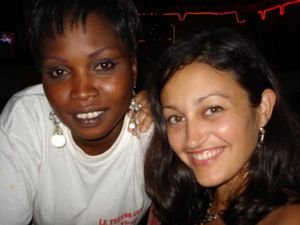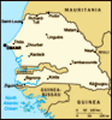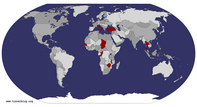Advertisement

 Les nanas
Les nanas
(The chicks.) This is Adia. Before I left she gave me a pair of custom-made sandals beaded with the colors of the Senegalese flag that she had made for me like a week before my departure!! One day I was invited to a local family's house in Medina—which is like the main
banlieue in Dakar—for lunch. The woman of the house is the first of three wives, and runs a three-story house full of kids and grandkids. After greeting countless relatives one of her daughters took me into her room to dress me in proper Senegalese garb so I wouldn’t look like quite such a
toubabe (I was wearing jeans and sunglasses!). She let me borrow a beautiful yellow
pagne (traditional wrap-around skirt) which she expertly tied around my waist, and a matching brown top. They know what they’re doing with their outfits; I was instantly more comfortable in the midday sun in the breezy, gauzy, loose-fitting linen than I’d been in my own clothes. In order for me to get the full experience of making thiéboudienne from start to finish, she and her young daughter then took me to the market to buy all the necessary supplies. The Medina market was a lot like any African market—full of female vendors in beautiful, vibrant
chitenjes behind baskets and sacks full of everything from onions to dry beans to homemade incense to dried fish—except that many of the

 Yoff beach at dusk
Yoff beach at dusk
In the distance you can see the little fishing boys I talked about in one of the earlier blogs...see how they look like they're dancing!items for sale were things I’d never seen before. Like
pain de singe or, literally, “monkey bread”—actually the fruit of the baobab tree that is sold in dry white chunks. I later discovered they blend it with fruit and then freeze it in tiny little plastic bags, making something like ice cream you suck out of a corner you tear off from the bag—super yummy and refreshing! There was also lots of green and red bissap leaves (green ones are citrus-y, red ones are made into a sweet juice). There is an entire section of the
marché devoted to medicinal plants and herbs.
The inside of the market was unlike anything I’d seen, though. The interior is reserved for the meat and fish vendors, and the entire place echoed loudly with the sound of huge knives slamming down on the curved, sanded blocks of wood the uniformly male meat- and fish-mongers cut their wares on. It was such an unbelievable frenzy of pungent smells, rhythmic movement and sound, and colors and textures. The shoppers were almost all women, wearing their beautiful fabrics, alongside male butchers in bloody aprons and stacks of fish swarmed by hordes of flies. The floor

 Fishermen on a traditional pirogue
Fishermen on a traditional pirogue
Sometimes they stay on a boat like this for several days at a time. Apparently there are some fisherwomen as well, though I have never seen them. But Senegal has gone through a big gender equality movement. There are now even female-driven taxicabs--they are identified by the name "Taxi Sisters" and don't drive at night.was covered in wet, smelly newspaper covered in fish scales. It was totally awesome! I was curious whether they always go to the same vendors each day for each specific purchase, or if they rotate. My guide said in general she always frequents the same vendors, except when it comes to fish and meat—then, she said, you have to go to whichever monger has the freshest stuff. After she eyed the various morcels for sale as suspiciously as possible for a while, and then negotiated a price, she bought a huge chunk of some fish I couldn’t identify and they couldn’t translate—it was intended to feed about 13 or 14 people and cost around $18.
We then went back through the vegetable market, which spreads all around the outside of the enclosed fish and meat hall. We bought a huge bunch of green bissap leaves from a very old woman, as well as some stinky, soggy tamarind; garlic; tomato paste, which is ubiquitous in Senegalese cooking; onions; cabbage; hot chili peppers; eggplant; carrots; mandioca (or cassava root—that white root they eat raw all over Mozambique, for those of you who saw our photos from last summer); parsley; bouillon cubes,

 Fish closeup
Fish closeup
These are the little fish the kids catch during the day...our friend bought them and ate them for dinner--naturally bringing the plate over to us so we could all partake. They are just salted and blackened over fire, and served with marinated onions.which are possibly more inevitable than tomato paste here!; oh—and a hunk of super stinky dried fish.
Every woman has her own style of making thiéboudienne, but in retrospect I can say that I am very glad I learned it from Baye Fall's sister—hers--well, ours 😊--was SOOOO good. When we arrived back at the house we chatted for a while with the matriarch, who is more like a grandmother and is referred to by everyone in the house and in the quartier as "yabué" which means something like "elderwoman." I spent all morning in the taxi practicing my greeting to her: Yabué, nagadef! Which is,"elderwoman, how are you" in Ouolof.
We then went back to the kitchen, which is basically an open room with a couple of stools and tons of huge cooking vessels stacked around the floor. Cooking is done on top of a squat gas tank and chopping is done—as it is all over Africa—in the hand, with no cutting board or other surface to set things down on.
* * * * * * * * * * * * * * * * * * * * * * * * * *

 Sitting on the beach at dusk
Sitting on the beach at dusk
Here we are at Tefess Gui. I look perpelexed because I was fascinated by how Baye Fall could get his locks into a perfect ponytail without a rubber band!* * * * * * * *
How to make thiéboudienne First all the veggies got washed in a huge bowl, while vegetable oil was heating up in a huge cauldron. Once it was hot, we added a handful of salt (salt goes in first thing, which is interesting--I've never seen that before), then a handful of onions, and after those turned golden, we added a whole bunch of tomato paste. This combination—onion, oil, and tomato paste--is the base for a lot of dishes here. After the tomato paste started melting into the oil, turning it a deep, rich rusty-red color, we added a couple of small cupfuls of water and let it simmer. Then we carefully set the veggies into the pot—a ton of bissap leaves, two small heads of cabbage cut in half, two carrots cut in quarters, some chunks of mandioca, two whole hot peppers, and two small eggplants sliced in half.
As that began to simmer, his sister cleaned the fish while I pounded together in a huge mortar whole peppercorns, whole dried hot chiles, garlic, and parsley, into a mush. (This delicious smelling mixture would later be stuffed into finger-sized holes the sister

 I figured it out
I figured it out
He wraps one strand around the rest and it magically stays.made in the fish chunks—flavor country!!) We then gently laid the raw fish, stuffed with little dabs of the garlic/parsley/chile mush, into the pot to simmer. As she explained to me, this is the Saint-Louis style of making thiéboudienne; in Dakar, they fry the fish first before adding it, but she says that doesn't allow the flavor to seep into the sauce so in Saint-Louis they put it straight in, raw. She then added the dried fish (uber smelly!!), as well as another garlic/chile paste and the mandatory Maggi cubes.
Once the fish was cooked, she gently removed all the fish and veggies from the pot, setting them aside in a bit of the cooking liquid, covered, such that only sauce remained in the pot. She then washed the rice (you use broken rice for thiéboudienne so it must be rinsed several times) and smushed it down into a huge colander—leaving a hole in the very center—which she set over the pot to steam. Once the rice was aldente, it was put aside, and she tested the sauce for saltiness. She then put the rice directly into the pot of sauce, stirred it, and let it sit for a

 Another picture from the street market in downtown Dakar
Another picture from the street market in downtown Dakar
You can kind of see two men wearing the traditional bou-bou there on the left, but not very well. I lost all my photos of Malick and Baye Fall wearing theirs. At first upon arriving here it was strange, seeing all these men wearing floor-length shirts with pointy shoes. But it's actually very beautiful. It's totally normal to see young men wearing regular Western clothes one day, and then a bou-bou the next day. You can see better how it looks in the video.while. We came back 5 mins. later to stir again—by this time the rice was a deep reddish color and smelled amazing.
After another few minutes she tested the rice and determined it to be ready, and started scooping it all out into two huge bowls and one small bowl. (In Senegal, you always leave aside a portion of the meal in case someone unexpected—a friend, family member, or a stranger in need—shows up.) She left a tiny hole in the center of each pile of rice in each of the three bowls; I learned that this is for the scrapings off the bottom of the pot, where the rice has gotten a little burned and crunchy (some people consider that—the “rogne”—the best part of thiéboudienne). She then carefully arranged morcels of fish and vegetables in the center of each pile of rice, and then drizzled some of the remaining sauce over everything.
* * * * * * * * * * * * * * * * *
Everyone cheered when I walked in and started joking that this was going to be
thiéboudienne Américaine 😊 Like before, the older people ate with their hands

 Badiane in the kitchen at Hotel Claudia
Badiane in the kitchen at Hotel Claudia
He's preparing the garlic for another favorite Senegalese dish--crevettes à l'ail (shrimp sauteed in lots and lots of garlic).while us youth (do I still count as youth?!) used spoons. Next time I am using my hands for sure. There were so many of us we split into two groups of about 7 people all around two huge bowls. The thiéboudienne was fantastic; I was pleasantly surprised by a very strong citrus aroma, which apparently comes from the green bissap leaves. It was so yummy. My hosts were constantly putting big chunks of fish in front of my side of the bowl, and they also made sure I got a nice hefty chunk of the dried fish too 😊 At a loss for anything positive to say about it, I told them that it tasted a lot like some French cheeses—which is to say that it tastes like feet! But you don't taste that aspect of it in the dish as a whole; only if you bite into the dried fish itself. The hot peppers are left in the dish whole; they can be used to spice your "area" of the bowl by taking the pepper, rubbing it around on your area of rice. Then you put it back in the center.
Everyone crashed afterward; I know that

 Malick's girlfriend's cousins
Malick's girlfriend's cousins
When we were visiting they were supposed to be doing their homework but they were more interested in giving me detailed information about each of the family members in a little photo collage they had on the wall. They were adorable.sounds strange, but after a heavy meal like that, especially in warm weather, it's just natural to fall asleep! (Which is why I don't normally eat during the day.) And it is also totally acceptable and expected of you, even as a guest (I felt like it was rude, but it's really not). Everyone lays down somewhere, usually two or three to a bed or on the couch, and naps for a while. Then you wake up and have tea. We got up to go back to the market so I could take some pictures with my newly charged batteries which had died just as I had reached the market earlier, but not before I was given a 6-meter run of very beautiful, and high quality,
chitenje material to make myself an outfit with. They also insisted that I keep the beautiful
pagne they had dressed me in. It was such a lovely day!
Afterward I went looking for used guitars in another part of town but found the shop closed, so headed to Tefess Gui and sat on the beach for a while, watching the surfers and all the kids playing in the water and eating some beignets

 The blog in progress...
The blog in progress...
...I wasn't kidding when I said I write it on the spot. I don't have a notebook either so when I think of something or something cool happens I end up scribbling on anything, like my SIM card receipt or my Continental Airlines ticket jacket :)au poisson. It was pretty cold so the beach cleared out earlier than usual; once we had it almost to ourselves, Malick started singing some of his mbalax melodies over the sound of the waves crashing; it was so beautiful. That's one nice thing about making friends with a musician here, you are surprised by impromptu, free, private concerts in the coolest of places! That night I had the chance to hear Malick perform in front of an audience for the first time, which was the perfect way to end a perfect day. In the pictures you can see how to eat
beignets au poisson, what it's like being in bumper-to-bumper traffic in downtown Dakar in a taxi, and the Yoff beach scene just before the sun goes down. In the last one you can see the fat maman who sells me
beignets every day--she's carrying a green bucket containing her wares. On days when I wasn't hungry, she forced me to take one or two anyway, on the house 😊
Next: la Petite Côte!
love,
martina
Advertisement
Tot: 0.069s; Tpl: 0.014s; cc: 11; qc: 22; dbt: 0.0206s; 1; m:domysql w:travelblog (10.17.0.13); sld: 1;
; mem: 1.1mb










jim
non-member comment
Consistency
Senegal vs. Rome, sort of the same!!! Enjoyed the pics and your adventures. Sounds very interesting from a distance, but the Fish Thing would be of interest to you and Dad. Kristin and I will have to keep that at a distance.!!